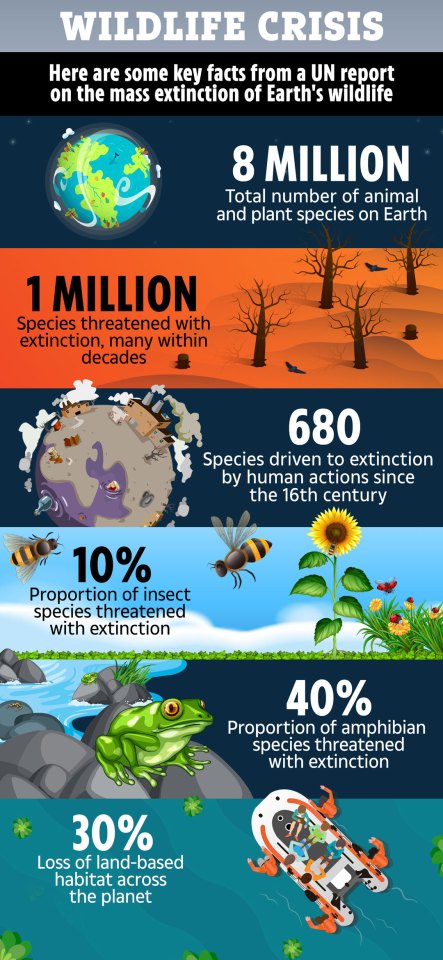Animals and plants are going extinct ‘at fastest rate since death of the dinosaurs 65million years ago’

ANIMALS and plants are dying out at the fastest rate since an asteroid wiped out the dinosaurs 65million years ago, scientists warn.
A study found that more than 500 land-based vertebrate species are on the brink of extinction in the next two decades as a result of human activities.
Researchers say these species are fading faster than previously thought. Their decline could have a devastating impact on the world's ecosystems.
The new study comes from scientists at the universities of Stanford and Mexico City who published a report in 2015 declaring the world's sixth mass extinction was already under way.
Based on their findings, the researchers now believe this mass extinction is currently accelerating.
They are calling for immediate global conservation actions to prevent a "catastrophic ecosystem collapse".
Paul Ehrlich, from Stanford University in California and one of the authors on the study, said: "When humanity exterminates populations and species of other creatures, it is sawing off the limb on which it is sitting, destroying working parts of our own life-support system.
"The conservation of endangered species should be elevated to a national and global emergency for governments and institutions, equal to climate disruption to which it is linked."
More than 400 vertebrate species became extinct in the last 100 years - extinctions that would have taken up to 10,000 years in the normal course of evolution, the researchers said.
Examples include the ivory billed woodpecker, and the Round Island burrowing boa and, more recently, the golden toad.
To better understand the current extinction risk faced by some of the creatures, the team looked at the abundance and distribution of critically endangered species.
They did this using data from the International Union for the Conservation of Nature (IUCN) Red List of Threatened Species and from Birdlife International.
They found 515 (1.7 per cent) out of 29,400 species analysed are on the brink of extinction, with less than 1,000 individuals remaining in each species.
Those on the brink of extinction are located mainly in tropical and subtropical regions, in areas that are heavily affected by human activities, the researchers said.
Terrestrial vertebrates facing extinction include species such as the Sumatran rhino, the Clarion island wren, the Espanola Giant Tortoise and the Harlequin frog.
Additional analysis suggests more than 237,000 populations of mammal and bird species on the brink have vanished since 1900.
These declines are being driven by wildlife trade and other human pressures such as such as population growth, habitat destruction, the wildlife trade, pollution and climate change, the researchers said.
A vast majority (84 per cent) of species with populations under 5,000 have been found to live in the same areas as species with populations under 1,000.
According to the team, this means the loss of endangered creatures could have a "domino effect" on other species.
Lead author Gerardo Ceballos, from the University of Mexico, said: "What we do to deal with the current extinction crisis in the next two decades will define the fate of millions of species.
"We are facing our final opportunity to ensure that the many services nature provides us do not get irretrievably sabotaged."
The rate of change is happening rapidly, according to Chris Johnson, Professor of Wildlife Conservation at the University of Tasmania.
"The current rate of extinction of species is higher than at any time since 65 million years ago, when the collision of a space-rock with the Earth killed off dinosaurs and many other species," Professor Johnson said.
Climate change explained
Here are the basic facts...
- Scientists have lots of evidence to show that the Earth’s climate is rapidly changing due to human activity
- Climate change will result in problems like global warming, greater risk of flooding, droughts and regular heatwaves
- Each of the last three decades have been hotter than the previous one and 17 of the 18 warmest years on record have happened during the 21stcentury
- The Earth only needs to increase by a few degrees for it to spell disaster
- The oceans are already warming, polar ice and glaciers are melting, sea levels are rising and we’re seeing more extreme weather events
- In 2015, almost all of the world's nations signed a deal called the Paris Agreement which set out ways in which they could tackle climate change and try to keep temperatures below 2C
"Threats to species in today's world - things like habitat destruction and climate change - are growing rapidly.
"This suggests that the rate of extinction may be about to increase further. The significance of this study is that it provides evidence for that impending rise in extinctions," he added.
"The tragedy of all of this is that we have the knowledge to save species from extinction, and doing that is cheap in a global context. But this task is just not given enough priority by society and governments."
The research was published in the journal Proceedings of the National Academy of Sciences.
Most read in Science
In other news, the UN recently warned that humans risk living in an "empty world" if we don't halt the mass extinction of wildlife.
Read More on The Sun
Humans are said to be putting more than one million animal species at risk of extinction.
And, here are some of the animals at risk of extinction and how we might save them.
We pay for your stories! Do you have a story for The Sun Online Tech & Science team? Email us at tech@the-sun.co.uk

















